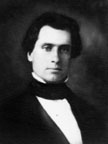History
 Oak Hill was built by John Robinson in 1847 on a hill overlooking the town, then a few thousand population, and close by the railroad he had helped to build.
Oak Hill was built by John Robinson in 1847 on a hill overlooking the town, then a few thousand population, and close by the railroad he had helped to build.
This Gothic Revival house has been the focal point of the view to the north from the center of town ever since. Although encroached upon by the city, the elevation and orientation of the house projects a vision of a nearly forgotten era across the intervening industrialized valley.
Robinson owned a large flour mill on Walnut Street and was Superintendent of the newly built Sandusky City and Mansfield Railroad. He was a business associate of Attorney Charles T. Sherman and his younger brother, John, who later became a Senator and author of the Sherman Anti-trust Act. Robinson’s choice to build in the Gothic Revival style reflected his sophistication in the latest trends in architecture. John Sherman also built his first home of similar style and grandeur in the same year. Its fate was to be turned into apartments in later years and torn down in the 1960s.
 Robinson and his family lived at Oak Hill until 1861, and five of his twelve children were born here. From about 1855 Robinson was associated with Wells Fargo Co. and involved with the establishment of the Great Southern Overland Mail. In 1861 he left Oak Hill on a trip to purchase a silver mine in Batopilas, Mexico. He operated the mine at great profit to his investors, who included Wells Fargo directors W. G. Fargo, Danford Barney, and Ashbel Barney.
Robinson and his family lived at Oak Hill until 1861, and five of his twelve children were born here. From about 1855 Robinson was associated with Wells Fargo Co. and involved with the establishment of the Great Southern Overland Mail. In 1861 he left Oak Hill on a trip to purchase a silver mine in Batopilas, Mexico. He operated the mine at great profit to his investors, who included Wells Fargo directors W. G. Fargo, Danford Barney, and Ashbel Barney.
In the late 1850s, Dr. Johannes Aten Jones, an eye, ear, and nose specialist, advertised that he was coming to this area to treat patients. One of his patients was Amanda Barr. Dr. Jones fell in love with Amanda’s sister Frances Ida, and they were married in 1861. She was seventeen and he was thirty-one.
In 1864 Frances persuaded Dr. Jones to buy Oak Hill for her. When Dr. Jones bought the house, he replaced fireplace surrounds and mantel shelves with the ones that are presently in the house, except the two in the parlor, which are original; the other five are different from these, and each other, and are Italian marble.
On the marble mantle in the dining room there is a letter “J” carved into it. He also imported the beautiful framed mirrors from France. Natural gas service was available in 1864, and Dr. Jones had the service brought to Oak Hill to use for lighting and heating. All but four of the chandeliers in the house are original. They were taken down during the restoration and refurbished and wired for electricity. Dr. Jones installed gas burners in the fireplaces to provide heat. Furnaces were installed prior to 1896, with ductwork to the first floor only.
 Indoor plumbing was installed in 1877, connected to the new city water works. Bathrooms on the first and second floors were installed, with hot and cold running water and a third tap for rainwater collected in the cistern.
Indoor plumbing was installed in 1877, connected to the new city water works. Bathrooms on the first and second floors were installed, with hot and cold running water and a third tap for rainwater collected in the cistern.
The furniture in the house was purchased by the Jones family. We have most of the original bills of purchase and can identify most of the pieces. Most of it was purchased in New York City and brought to Mansfield by train.
The property was divided and sold in 1923 after the eldest daughter, Ida, died. Leile, one of the Joneses’ daughters, moved back into the house in 1947 amongst its furnishings of bygone days, until she sold the house and its contents to the Richland County Historical Society in 1965. It was always her hope that one day her family home would be restored to its original splendor.
